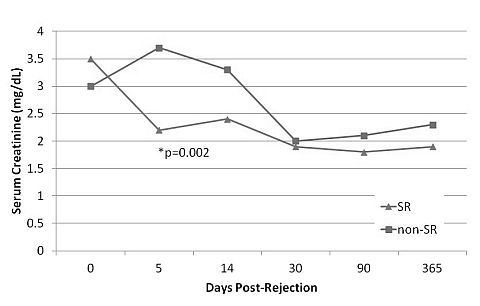Application of Rejection Reversal as Defined by Efficacy Endpoints in Present Day Renal Transplantation
The Methodist Hospital, Houston, TX
Meeting: 2013 American Transplant Congress
Abstract number: D1588
In the 1990s, the Efficacy Endpoints (EE) studies proposed criteria for 'successful' response to rejection treatment based on serum creatinine (Cr) as a marker of renal function recovery. The purpose of this study was to determine the applicability of this criteria in the present era. This review included 109 patients experiencing at least one biopsy-proven acute rejection. Successful responders (SR) were defined as patients with a return of Cr to ≤ 110% of the rejection Cr (Cr prior to treatment) by day 5 of therapy. Graft function and survival were examined through one year post-rejection. Distinctions, particularly in race, immunosuppression and rejection grades between EE and current study recipients are shown below.
| Efficacy Endpoints | Current Study | |
| Mean Age, years | 39 | 47 |
| Male, % | 62 | 61 |
| African American, % | 12 | 28 |
| Caucasian, % | 81 | 48 |
| Deceased Donor, % | 85 | 62 |
| 1st Transplant, % | 87 | 88 |
| 2nd Transplant, % | 11 | 11 |
| Peak PRA, mean, median (range) | 16, 0 (0-100) | 30, 10 (0-100) |
| Antibody Induction, % | 50 | 96 |
| Maintenance Immunosuppression, % | ||
| Cyclosporine, 91 | Tacrolimus, 89 | |
| Azathioprine, 82 | Mycophenolate, 84 | |
| Prednisone, 96 | Prednisone, 84 | |
| Banff Grade | ||
| – Borderline, % | 3 | 11 |
| – Grade 1(1a/b), % | 41 | 57 |
| – Grade 2(2a/b), % | 38 | 28 |
| – Grade 3, % | 18 | 3 |
| – Antibody Mediated, % | – | 32 |
In the current study, mean day 5 Cr was 79% of the rejection Cr, and 97 (89%) patients were considered SR, with no differences in baseline characteristics seen between SR and non-SR groups. Except for day 5, there were no differences in renal function or graft survival between SR and non-SR groups (86% vs. 79%, respectively).

Furthermore, there was no difference in the relative change of day 5 Cr from the rejection Cr between those with or without graft loss at 1 year (79% vs. 81%). Response to rejection treatment based on Cr did not correlate with graft outcomes in our population. This finding most likely represents the evolution in patient demographics, immunosuppression, and severity of rejection episodes in present times. Based on these results, utilization of additional markers may be necessary to define successful outcomes following rejection.
To cite this abstract in AMA style:
Jantz A, Patel S, Moore L, Knight R, Gaber A. Application of Rejection Reversal as Defined by Efficacy Endpoints in Present Day Renal Transplantation [abstract]. Am J Transplant. 2013; 13 (suppl 5). https://atcmeetingabstracts.com/abstract/application-of-rejection-reversal-as-defined-by-efficacy-endpoints-in-present-day-renal-transplantation/. Accessed December 9, 2025.« Back to 2013 American Transplant Congress
